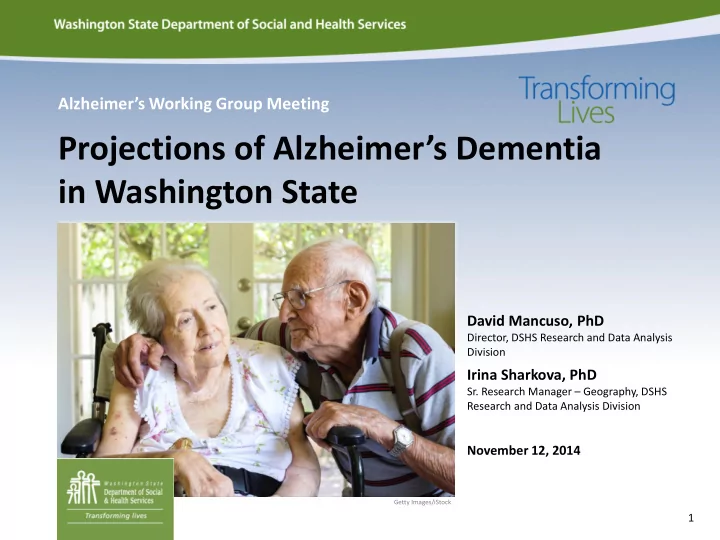

Alzheimer’s Working Group Meeting Projections of Alzheimer’s Dementia in Washington State David Mancuso, PhD Director, DSHS Research and Data Analysis Division Irina Sharkova, PhD Sr. Research Manager – Geography, DSHS Research and Data Analysis Division November 12, 2014 Getty Images/iStock 1 1
Approaches to Estimation Data on disease prevalence • Prevalence estimates are derived from clinical studies or population surveys • Prevalence rates by age and gender are calculated from the study population, then applied to state population estimates Prevalence rates of Alzheimer’s Dementia (AD) • From two major ongoing studies of dementia: – Aging, Demographics, and Memory Study (ADAMS) - Plassman et al (2007) – Chicago Health and Aging Project (CHAT) - Hebert et al (2003; 2013) • National survey – American Community Survey (ACS) by US Census Bureau Differences in AD prevalence rates due to: • AD diagnostic differences (include or exclude mild cognitive impairment and non-AD dementias) • Whether a clinician participated in the study or the results were self-reported only 2 2
Forecasting Approach Data on future population by age • Washington State Office of Financial Management, Forecasting and Research Division: Forecast of the State Population by Age and Sex, 2010-2040, November 2013 Models • Extrapolation – Multiply each population subgroup in the population forecast by their AD prevalence rate, prevalence rates do not change with time (Plassman, 2007) • Macro-cell simulation – Imitates what happens in a real population using AD incidence rate and AD mortality rate by age to calculate people with and without AD at the base year, then “aging” them by 1 year, adding new AD cases, subtracting persons who died from AD and non-AD causes, and repeating the process for every year of the forecast (Hebert 2013) • Our approach – Extrapolations using prevalence rates from three sources, one model relies on prevalence rates from a macro-cell simulation model Projections for Washington in 2040 Alzheimer's Dementia Serious Cognitive Difficulty Any Dementia 3 Models (Hebert, 2013) (2013 ACS) (Plassman, 2007) Age 65 years and older 65 years and older 70 years and older Persons with . . . 270,000 233,000 215,000 3 3
Projections of Alzheimer’s Dementia in Washington State 270,222 65+ with Alzheimer’s Dementia 232,948 (Herbert) 30-YEAR INCREASE = 181% 215,227 2015 ESTIMATES 108,218 106,644 85,188 65+ with Serious Cognitive Difficulty 96,156 (2013 ACS) 92,451 30-YEAR INCREASE = 152% 77,058 70+ with Dementia (Plassman) 30-YEAR INCREASE = 179% 2010 2015 2020 2025 2030 2035 2040 4 4
Projections of Alzheimer’s Dementia in Washington State, 2010 – 2040 Synthetic projections using national prevalence rates from Hebert et al (2013) 85+ years 75-84 years 65 to 74 years 2010 2015 2020 2025 2030 2035 2040 2010 2020 2030 2040 NUMBER PREVALENCE NUMBER PREVALENCE NUMBER PREVALENCE NUMBER PREVALENCE 65 -74 years 13,717 3.0% 23,600 3.1% 29,180 3.3% 28,187 3.4% 75 - 84 years 44,561 17.6% 58,251 16.7% 101,581 17.2% 124,500 18.0% 85+ years 37,879 32.3% 44,121 32.2% 65,255 32.9% 117,535 34.6% Total 65+ 96,156 11.6% 125,973 10.1% 196,015 11.7% 270,222 14.5% DATA SOURCES Total Population 65 and Over, by Age: Washington State Office of Financial Management, Forecasting and Research Division. Forecast of the State Population by Age and Sex: 2010-2040. Nov. 2013 . National Prevalence of Alzheimer's Dementia for Persons 65+, by Age: Hebert L.E., Weuve J., Scherr P.A., and D.A. Evans. Alzheimer disease in the United States (2010 – 2050) estimated using the 2010 census. Neurology May 7, 2013 80:1778-1783. 5 5
Persons with Any Dementia in Washington, 2010 – 2040 Synthetic projections using national prevalence rates from Plassman et al (2007) 85+ years 75 to 84 years 70 to 74 years 2010 2015 2020 2025 2030 2035 2040 2010 2020 2030 2040 NUMBER PREVALENCE NUMBER PREVALENCE NUMBER PREVALENCE NUMBER PREVALENCE 70 -74 years 5,005 2.7% 9,078 2.7% 11,465 2.7% 10,812 2.7% 75 - 79 years 11,422 8.0% 17,609 8.0% 28,029 8.0% 30,586 8.0% 80 – 84 years 18,812 16.9% 21,975 16.9% 40,965 16.9% 52,693 16.9% 85+ years 41,819 35.7% 48,862 35.7% 70,729 35.7% 121,136 35.7% Total 70+ 77,058 13.8% 97,524 11.8% 151,188 12.4% 215,227 15.0% DATA SOURCES Total Population 70 and Over, by Age: Washington State Office of Financial Management, Forecasting and Research Division. Forecast of the State Population by Age and Sex: 2010-2040. Nov. 2013. National Prevalence of Any Dementia for Persons 70+, by Age: DSHS ADSA Age Wave Forecasts, 2010-2020; calculated from B.L. Plassman, K.M. Langa, G.G. Fisher et.al. Prevalence of Dementia in the United States: The Aging, Demographics, and Memory Study. Neuroepidemiology 2007; 29:125 – 132. 6 6
Persons with Serious Cognitive Difficulties in Washington, 2010 – 2040 Synthetic projections using Washington state prevalence rates from the 2013 American Community Survey 85+ years 75-84 years 65-74 years 2010 2015 2020 2025 2030 2035 2040 2010 2020 2030 2040 NUMBER PREVALENCE NUMBER PREVALENCE NUMBER PREVALENCE NUMBER PREVALENCE 65 - 74 years 29,223 6.4% 49,043 6.4% 57,439 6.5% 53,885 6.5% 75 – 84 years 27,830 11.0% 36,827 10.6% 63,796 10.8% 76,526 11.1% 85+ years 35,398 30.2% 41,360 30.2% 59,869 30.2% 102,537 30.2% Total 65+ 92,451 11.2% 127,230 10.2% 181,104 10.8% 232,948 12.5% DATA SOURCES Total Population 65 and Over, by Age: Washington State Office of Financial Management, Forecasting and Research Division. Forecast of the State Population by Age and Sex: 2010-2040. Nov. 2013 . Washington State Prevalence of Serious Cognitive Difficulty for Persons 65+, by Age: US Census Bureau. 2013 American Community Survey 1-Year PUMS files. Online at http://www.census.gov/acs/www/data_documentation/data_ferrett_for_pums/, accessed 11-03-2014. 7 7
Microsoft/Free Domain Questions? 8 8
Recommend
More recommend